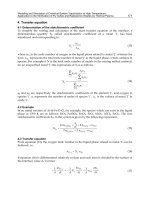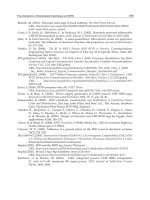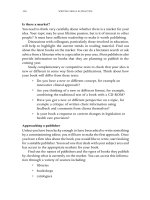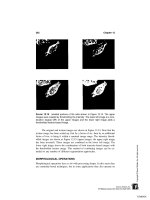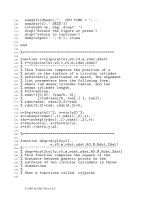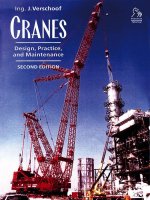Cranes – Design, Practice, and Maintenance phần 10 pdf
Bạn đang xem bản rút gọn của tài liệu. Xem và tải ngay bản đầy đủ của tài liệu tại đây (964.6 KB, 34 trang )
Miscellaneous 295
plate of the hopper and the side plates, should be flattened out in order
to prevent the clogging of the material in the hopper in sharp corners.
It is strongly advisable to build a sturdy grid in the top of the hopper
as it cushions the shocks when the material is dropped into the hopper
by the grab. It also catches lumps, wood, and all other rogue material
and prevents clogging in the chutes of the conveyor-belt system in the
unloader and behind the unloader. The walls of the hopper can wear
out rather quickly through the abrasion, particularly by wet material.
Abrasion resistant plates can be built-in to prevent this wear as far as
possible. If required a dust-suppression system can be built-in as well
as vibrators to prevent clogging of the material.
9.8 Apron feeders; conveyors
To unload the hopper a number of mechanisms can be used, for
example:
– apron feeders (for ore and similar materials);
– heavy duty belt conveyors (for coal);
– vibrating feeders.
Each mechanism has its own advantages and disadvantages. Apron
feeders and conveyors in an unloader can only offer a very limited
distance for transportation. The heavy load from the material in the
fully-loaded hopper resting on the feeder or belt, and the extra force
which is needed to draw the material out of the hopper, require con-
siderable power.
Problems with hoppers and conveyors can be overcome as follows:
– A wide feeder with enough body to take up the impact of the
material in the hopper should be used.
– A grid in the top of the hopper should be fitted to cushion the
shocks of the material dropping out of the grab opened above the
hopper.
– Construction of skirts between the hopper and the conveyor must
be very carefully engineered in order to prevent damage to the
conveyor or apron feeder.
– Enough power must be available to drive the conveyor and apron
feeder. The brake-out-force from the material out of the hopper
can be considerable.
Cranes – Design, Practice, and Maintenance296
Fig. 9.8.1 Hydraulic drive for conveyor underneath a hopper
An approximate method of calculation of the required horsepower for
a conveyor underneath a hopper is given.
Main characteristics
Capacity: QG2500 t͞hr
Material: Coal, density dG1t͞m
3
Conveyor speed: ûG0,6 m͞sec
Length of the loaded part of the
conveyor: LG8m
Opening width of the hopper: BG1,8 m
Height of the load on the
HG
Q
B · d · û · 3600
m
conveyor:
HG
2500
1,8 · 1 · 0,6 · 3600
HG0,64 m
Miscellaneous 297
1. Resistance by the hopper and
N
1
G
2 ·
µ
· L · d · H
2
· û · 10
3
102 ·
η
conveyor skirts (kW):
N
1
G
2 · 1 · 8 · 1 · 0,64
2
· 0,6 · 10
3
102 · 0,9
N
1
G43 kW
2. Resistance through ‘drawing
N
2
G
µ
1
· B · L
1
· û · 10
3
102 ·
η
out the material’ out of the
full loaded hopper (kW):
N
2
G
0,5 · 1,8 · 6,5 · 0,6 · 10
3
102 · 0,9
N
2
G38 kW
3. Resistance through the moving
N
3
G
f · G
m
· L
11
· û
102 ·
η
conveyor itself (kW):
where:
fGresistance coeff. of the
moving conveyor: fG0,65
G
m
Gweight of the moving part
per metre of the upper
and under strand: G
m
G240 kg͞m
L
11
Gcentre to centre length of
the end drums: L
11
G9,5 m
ûGconveyor speed: ûG0,6 m͞sec
η
Gtotal efficiency:
η
G0,9
N
3
G
0,65 · 240 · 9,5 · 0,6
102 · 0,9
N
3
G10 kW
The necessary motorpower to
drive the conveyor is: NGN
1
CN
2
CN
3
kW
NG43C38C10G91 kW
Cranes – Design, Practice, and Maintenance298
9.9 Electronic Tracking Guide System
C E Plus GmbH of Magdeburg in Germany have developed a fully
patented Electronic Tracking Guide System, which can be used for the
crane travelling mechanisms of overhead cranes, bridge cranes and simi-
lar equipment. These cranes must be equipped with separate AC fre-
quency units for the travelling mechanisms on each rail. The system
works as follows:
– On one rail two sensors are built-in, in front of the outer wheels.
(See Fig. 9.9.1.)
– These sensors measure, without contact, the distance between the
flange of the wheel and the side of the crane rail.
– If a difference between the measurements of the sensors arises dur-
ing crane travelling, the controlling computer between the drives,
commands one of the frequency converters to speed-up or to slow-
down the travelling a little. The speed of one side of the crane is
thus regulated in such a way that the distance between the rail and
the wheelflange is corrected. In this way the skidding of the crane
is prevented.
Fig. 9.9.1 The electronic tracking guide system
Miscellaneous 299
The two sensors control these distances continuously and in doing so
prevent the flanges of the wheels from hitting the side of the crane rail.
Therefore, wear and tear of the wheel flanges and the crane rail can be
minimized. In order to give the system enough time to react, the
free space between the rail and the wheelflanges, which is normally
12–15 mm, should be increased to 30 to 50 mm. Experience with a
35 ton overhead crane with a maximum travelling speed of 100 m͞min
has shown that the system works well.
9.10 Gears
There are a number of sophisticated computer programs with
which gearings can be calculated. ISO, DIN and AGMA have – among
others – comprehensive calculations for all sorts of gearing
arrangements.
Fig. 9.10.1 Gearbox for a hoisting mechanism
In this section only a rough calculation method for helical gears is
given, which can be used to get an idea of the way in which gears should
be dimensioned and calculated. This calculation method is derived from
A. K. Thomas, Wissmann, Niemann and Verschoof.
For a more comprehensive explanation of this complicated subject,
please study the ISO, DIN or AGMA calculations.
Cranes – Design, Practice, and Maintenance300
Calculation on fatigue (pitting)
N
all
Gk
1
· b · d
2
n
· y
1
· Q
w
·
n
2 · 10
5
kW
where
– Power which can be
transmitted: N
all
in kW
– Modulus: m in cm
– Number of teeth: z
1
pinion
z
2
wheel
– Pitch diameter: d
0
dGm · z (cm)
– Helix angle:
β
degrees
– Addendum coefficient: x
1
x
1
GC ···
·
m (cm)
x
2
x
2
GC ···
·
m (cm)
– Centre distance: a cm
aG
(z
1
Cz
2
) · m
2 cos
β
C
(x
1
Cx
2
) · m
cos
β
cm
– Allowable strength for pitting: k
1
k
1
G360 kg͞cm
2
for 17 CrNiMo6
k
1
G60 kg͞cm
2
for C60N
– bGwidth of pinion and wheel: b
1
in cm
b
2
in cm
– d
n
Gtheoretical pitch diameter: d
n
in cm
d
n
G
m · zC2 · x · m
cos
2
β
– yGCoefficient: y
1
y
1
for pinion
y
2
y
2
for wheel
Miscellaneous 301
Fig. 9.10.2 Bucyrus-Erie 1300 walking dragline
Cranes – Design, Practice, and Maintenance302
– Q
w
Gcoefficient, related to helix angle
β
Q
w
G 1,0 1,11 1,22 1,31 1,40 1,47 1,54 1,60 1,66 1,71
β
0
G 0° 5° 10° 15° 20° 25° 30° 35° 40° 45°
– Number of revolutions: n
1
for pinion, in rev͞min
n
2
for wheel, in rev͞min
N
all
Gk
1
· b · d
2
n
· y
1
· Q
w
·
n
2 · 10
5
kW
– Power to be transmitted: N (with . . . % rating)
f
p
G2,2G50 000 hours
– f
p
G
N
all
N
f
p
G1,75G25 000 hours
f
p
G1,40G12 500 hours
Calculation on strength
σ
b
G
F · q
b · m · e · Q
kg͞cm
2
where:
–
σ
b
Gbending stress:
σ
b
in kg͞cm
2
– Power to be transmitted: N in kW
– Nominal force on the teeth: F in kg
FG
N · 95 500
n · d͞2
kg
– Number of revolutions: n in rev͞min
– Nominal pitch diameter: ddGm · z (cm)
– Modulus: m in cm
– Multiplication coefficient depending
on addenum, X
1,2
: q
– bGwidth of pinion and wheel: b
1
in cm
b
2
– Coefficient depending on the
numbers of the mating teeth: e
– Coefficient, depending on the helix
angle
β
Q
Miscellaneous 303
– Multiplication coefficient q,
depending on X
1
, X
2
Z G 10 12 15 20 25 30 40 60 90 150
— C0,5 qG2,9 2,8 2,7 2,6 2,55 2,5 2,45 2,4 2,35 2,3
— C0,4 qG3, − 2,9 2,8 2,65 2,6 2,55 2,5 2,45 2,4 2,35
— C0,3 qG3,3 3,1 2,9 2,75 2,7 2,6 2,55 2,5 2,45 2,4
XGC0,2 qG3,7 3,4 3,2 2,9 2,8 2,75 2,65 2,6 2,45 2,4
— C0,1 qG4,3 3,9 3,5 3,1 3, − 2,9 2,8 2,65 2,5 2,45
— C0, − qG 4,5 3,9 3,4 3,2 3,1 2,9 2,7 2,55 2,5
— A0,1 qG 4,5 3,8 3,4 3,3 3, − 2,8 2,6 2,55
— A0,2 qG 4,2 3,7 3,4 3,2 2,95 2,7 2,6
— A0,3 qG 4,1 3,65 3,35 3,1 2,8 2,7
— A0,4 qG 4,4 3,9 3,5 3,2 2,9 2,75
— A0,5 qG 4,1 3,7 3,35 3, − 2,85
– Coefficient e:
Nos. of teeth Z
1
12 14 18 28 50 100
Nos. of 12 1,25 1,25 1,25 1,35 1,45 1,50
teeth Z
2
18 1,30 1,30 1,30 1,45 1,50 1,55
50 1,30 1,35 1,35 1,50 1,60 1,65
100 1,30 1,35 1,40 1,55 1,65 1,70
S 1,30 1,35 1,45 1,60 1,70 1,75
– Coefficient Q:
QG 1,0 1,2 1,28 1,33 1,35 1,36
β
G 0° 5° 10° 15° 20° 25°
σ
max
G
F · q
b · m · e · Q
kg͞cm
2
σ
allowed
σ
¯
σ
¯
G2000 kg͞cm
2
for 17 CrNiMo6
σ
¯
G1600 kg͞cm
2
for C60N
f
s
G
σ
all
σ
max
Cranes – Design, Practice, and Maintenance304
Example
Gearbox for hoisting
mechanism 1st stage 2nd stage 3rd stage
Power to be transmitted 800 kW 784 kW 768 kW
Gear ratio 2,35 2,68 3,05
Total gear ratio 2,35 · 2,68 · 3,05G19,20
Numbers of rev͞min of pinion 800 r͞min 340,4 r͞min 127 r͞min
Numbers of rev͞min of wheel (340,4 r͞min) (127 r͞min) (41,6 r͞min)
Centre distance a 28,0 cm 40,0 cm 63,0 cm
Numbers of teeth of pinion Z
1
G20 Z
1
G19 Z
1
G19
Numbers of teeth of wheel Z
2
G47 Z
2
G51 Z
2
G58
Normal module 0,8 cm 1,1 cm 1,6 cm
Face width of pinion 14,0 cm 20,0 cm 28,0 cm
Face width of wheel 13,6 cm 19,6 cm 27,6 cm
Addendum coefficient of pinion C0,5 C0,3 C0,2
Addendum coefficient of wheel C0,3 C0,3 A0,2
Helix angle
β
° 12° 12° 12°
Cosinus
β
° 0,9781 0,9781 0,9781
Material of the pinion 17CrNiMo6 17CrNiMo6 17CrNiMo6
Hardened and ground Hardened and ground Hardened and ground
Material of the wheel Same Same Same
Control of centre
aG
(20C47) · 0,8
2 · 0,9781
aG
(19C51) · 1,1
2 · 0,9781
aG
(19C58) · 1,6
2 · 0,9781
distance a
C
(0,5C0,3) · 0,8
0,9781
C
(0,3C0,3) · 1,1
0,9781
C
(0,2A0,2) · 1,6
0,9781
G27,40C0,65 G39,36C0,67 G62,98C0
G28 cm G40 cm G63 cm
k
1
360 kg͞cm
2
360 kg͞cm
2
360 kg͞cm
2
b
1
(Gbearing width b
1
G13,6 cm b
1
G19,6 cm b
1
G27,6 cm
of b
2
)
d
n
G
m · zC2 · x · m
cos
2
β
G
0,8 · 20C2 · 0,5 · 0,8
0,9781
2
G
1,1 · 19C2 · 0,3 · 1,1
0,9781
2
G
1,6 · 19C2 · 0,2 · 1,6
0,9781
2
G17,27 cm G22,53 cm G33,44 cm
y
1
y
1
G0,19 y
1
G0,19 y
1
G0,191
Q
w
Q
w
G1,26 Q
w
G1,26 Q
w
G1,26
n
1
n
1
G800 r͞min n
1
G340,4 r͞min n
1
G127 r͞min
N
all
Gk
1
· b · d
2
n
· y
1
· Q
w
·
n
2 · 10
5
kW
N
all
N
all
G1397 kW N
all
G1459 kW N
all
G1597 kW
NNG800 kW NG784 kW NG768 kW
Pitting
f
p
GN
all
:Nf
p
G1397 :800 f
p
G1459 :784 f
p
G1597 :768
G1,75 G1,86 G2,08
Strength
Miscellaneous 305
σ
b
G
F · q
b · m · e · Q
kg͞cm
2
FG
N · 95 500
n · (m · z)͞2
FG
800 · 95 500
800 · (0,8 · 20)͞2
FG
784 · 95 500
340,4 · (1,1 · 19)͞2
FG
768 · 95 500
127 · (1,6 · 19)͞2
FFG11 937 kg FG21 048 kg FG37 994 kg
z
1
z
1
G20 z
1
G19 z
1
G19
X
1
X
1
GC0,5 X
1
GC0,3 X
1
GC0,2
qqG2,6 qG2,75 G2,96
b 14,0 cm 20,0 cm 28,0 cm
m 0,8 cm 1,1 cm 1,6 cm
e 1,37 1,365 1,37
Q (helix angleG12°) 1,3 1,3 1,3
σ
σ
G
11 937 · 2,6
14 · 0,8 · 1,37 · 1,3
σ
G
21 048 · 2,75
20,1 · 1,1 · 1,365 · 1,3
σ
G
37 994 · 2,96
28 · 1,6 · 1,37 · 1,3
G1556 kg͞cm
2
G1482 kg͞cm
2
G1409 kg͞cm
2
σ
¯
allowed
σ
¯
G2000 kg͞cm
2
σ
¯
G2000 kg͞cm
2
σ
¯
G2000 kg͞cm
2
f
sG
σ
all
σ
f
s
G1,28
f
s
G1,35
f
s
G1,42
9.11 The Promo-Teus Conveyor Belt System
Halmij BV, situated near Gorinchem in the Netherlands, has developed
a fully patented Modular Container Conveyor Belt System for the
internal transport of containers on a terminal.
The system is built up of standard modules; one module for length
transport and one module for transverse transport. When used in com-
bination with special intersections the complete horizontal transport of
containers over a terminal can be arranged. Because of the modular
design all containers on the system can have completely different and
independent routings at the same time.
The system is fully scaleable and can thus be used for either large or
small operations. Each container is carried via the four corner castings by
the two, speciallydesigned narrow belts. Theruggedized belt construction
allows a smooth transfer of the containers between the belts. The belt
speed is variable; the maximum speed of the container is approximately
1m͞sec. Figures 9.11.1 to 9.11.3 show a test site of Promo-Teus.
Cranes – Design, Practice, and Maintenance306
Fig. 9.11.1 Promo-Teus
Fig. 9.11.2 Container being loaded
Miscellaneous 307
Fig. 9.11.3 The belt system of Promo-Teus
This page intentionally left blank
Chapter 10
Maintenance
General
With a well made piece of equipment, maintenance becomes a major
factor to keep this machinery in good condition. An organization with
reliable maintenance engineers should be formed to do this important
job. Discipline is needed to carry out regular inspections at the right
time and with the necessary care and attention.
For rolling equipment like straddle carriers and AGVs (Automated
Guided Vehicles), a well equipped workshop will be the best place to
concentrate all important maintenance jobs.
Moveable platforms which can surround the taller equipment such
as straddle carriers can be useful, as can moveable grease guns with
long, flexible grease hoses and moveable drain containers. Special cricks
can help to change heavy tyres rapidly and easily.
The extensive maintenance manuals normally give enough infor-
mation about the frequency of inspection and the items which are to be
checked and maintained. The same principles apply to mobile cranes
which are able to move around freely. However, as they are normally
too large to be worked on inside a workshop, the maintenance must be
carried out in situ or in a predetermined maintenance position at the
terminal or quay. Refuelling of the diesel engines also needs to be
organized with precision.
For cranes running on rails, such as the many types of ship-unloading
and loading equipment, stacking cranes, etc. the maintenance work
must be carried out in situ. The complete systems and the automation
require specialist skills. The training of a suitable team of operatives is
Cranes – Design, Practice, and Maintenance310
expensive and time consuming, but absolutely necessary. Inspection and
maintenance of the hydraulic equipment similarly demands specialist
knowledge and a sound understanding of the systems which are in use.
Mechanical engineers must inspect the wire ropes and wire rope sys-
tems, hoist-, travel-, luff- and slew mechanisms, brakes, gearboxes, and
drums. Steel structures also require checking for fatigue cracking and
other faults. Bolts should be checked regularly for signs of loosening,
corrosion, cracking or other damage. Greasing and lubrication are an
important part of this whole process because while this essential pro-
cedure is being undertaken, the engineers can carry out visual, mechan-
ical and other testing at the same time. Greasing and lubrication need
to be thorough and not skimped on even though it is both costly and
messy. It is one of the most important ways in which the useful life
of equipment can be extended and the downtime through repair and
breakdown reduced.
Railtracks should be inspected from time to time, especially those
tracks which are laid on sleepers and ballast beds.
– Allowable deviation of the span if span⁄15 m, ∆G3mm
if span¤15 m, ∆Gto
10 mm increasing
– Allowable deviation of one rail
from the nominal straight line in
the horizontal plane max 1:1000
– Allowable deviation of one rail
from the nominal straight line in local 1:1000; over the full
the vertical plane length of the track 1:5000.
Maintenance manuals
Maintenance manuals should comprise:
– Introduction
– Technical main-characteristics
– Warning about the windspeeds in which the equipment can work
and should be locked against storms, etc.
– Safety demands and safety procedures
– General warnings; signals to be used
– Instructions for the use of fire-fighting equipment, etc.
– All sorts of drawings and information for instruction, layout of
mechanisms, etc.
– Certificates for the wire ropes
Maintenance 311
– Instructions for the use of oil and grease
– Intervals between inspection and control of mechanical and electri-
cal parts
– The instructions for the inspection of steel construction parts and
their conservation
– The allowed tolerances of the rail-tracks
– (The electrical system is normally described in separate mainten-
ance books.)
Maintenance periods
Regular maintenance is most important and will lengthen the lifetime of
the equipment, lessen the downtime and prevent damage. Maintenance
means, among others, a good greasing of all mechanisms, and also a
regular control of such simple items as bolts and nuts. An extra inspec-
tion is recommended after a heavy storm.
Inspections should be ‘visual’ when the mechanisms are at rest, and
also when they are working. It is also necessary to check the motor-,
coupling-, gearbox- and brake-temperatures during working and the
wear-and-tear of small items such as brake-pads and brake-linings.
Fig. 10.1.1 2000 ton erection crane
Cranes – Design, Practice, and Maintenance312
The general lifetime of wire ropes has been mentioned in Section 2.7.
In general the wire ropes of heavy duty, very frequently used cranes
will have a restricted lifetime. Mechanical damage through hitting cells
and hatches often occurs. Boom-hoist wire ropes have a lifetime of 5 to
8 years.
Maintenance 313
Cranes – Design, Practice, and Maintenance314
The first time that the oil in gearboxes has to be changed is after
some 500 working hours. Check then carefully whether mineral oil or
synthetic oil has been used in the gearboxes and follow the guidelines
which the oil-companies have given.
Slewing- and luffing-mechanisms
The same sequence of maintenance can be followed as for the trolley-
travelling mechanisms.
The rollers of double-row ball bearings in slewing mechanisms should
be greased after each 50 working hours. It is advised to use automatic-
ally and continuously working grease pumps.
Maintenance 315
Fig. 10.2.1. Multipurpose Mobile Feeder Server
Fig. 10.2.2 Multipurpoe Mobile Feeder server; rubber tyred crane drive units
and load support segment
Cranes – Design, Practice, and Maintenance316
Fig. 10.2.3 Kalmar Container Crane with 70 m span
Artwork Sources
Chapter 1
Fig. 1.1.1 Creative problem solving R. A. Kujawski and
L. L. Smith,
Chemical Engineering,
18 July 1988
Fig. 1.1.2 Wooden crane Visserijmuseum,
Vlaardingen
Photo A. Wapenaar
Fig. 1.1.3 Driving the hoist of Fig. 1.1.2 Visserijmuseum,
Vlaardingen
Photo A. Wapenaar
Fig. 1.1.4 The development of slewing level Maritiem Museum
luffing cranes from 1856–1956 Rotterdam
Fig. 1.1.5 The development of floating Maritiem Museum
cranes 1905– 1936 Rotterdam
Fig. 1.1.6 100 t mobile ‘all-purpose’ crane Liebherr, Nenzing
Fig. 1.1.7 Lemniscate grabbing crane Nelcon
Fig. 1.2.1 2500 t offshore crane Gusto͞Kone
Fig. 1.3.1 Container quay cranes Nelcon
Fig. 1.3.2 Automatic stacking cranes Nelcon
Fig. 1.3.3 Bulk unloader Nelcon
Fig. 1.3.4 Level luffing cranes Nelcon
Fig. 1.3.5 Bock crane Nelcon
Fig. 1.3.6 Autocrane for heavy loads Mannesmann Dematic
Fig. 1.3.7 Ringer crane Mammoet. van
Seumeren
Fig. 1.3.8 Floating derrick Hong Kong
Fig. 1.3.9 Two offshore cranes; each for Heerema͞Gusto Eng.
4000 t (by courtesy of Heerema͞
IHC Gusto Eng. BV)
Fig. 1.3.10 Tower crane Hensen
Fig. 1.3.11 Container mover Tracon, Rotterdam
Fig. 1.3.12 Excavator Caterpillar
Fig. 1.3.13 Shuttle carrier Kalmar
Fig. 1.4.1 Break-down of ship and gang Dr A. Ashar,
times (by kind permission of Lousiana State
Dr A. Ashar) University, U.S.A.
Fig. 1.4.2 Grab unloader Author
Fig. 1.4.3 Production scheme Author
Cranes – Design, Practice, and Maintenance318
Fig. 1.4.4 Double grab unloader IHC͞Holland Cranes
Fig. 1.5.1 The Beaufort scale Author
Fig. 1.6.1 Hatchless vessel, 22 across E. Vossnack
Fig. 1.6.2 Capacity, width and draft, etc. E. Vossnack
Fig. 1.6.3 Hatchless vessel ECT
Chapter 2
Fig. 2.1.1 Normal hoist wire rope scheme Author
for a container crane
Fig. 2.1.2 Wire rope scheme for grab- Author
unloader with main and
auxiliary trolley
Fig. 2.4.1 Wire rope types Author
Fig. 2.5.1 Fleet angles on drums Author
and sheaves
Fig. 2.5.2 Wire rope running off from the Norme Belge
drum; maximum allowable
deviation into the direction of the
groove, measured from the
tangent of the groove
Fig. 2.5.3 Wire rope running off from the Norme Belge
drum; maximum allowable
deviation against the direction of
the groove, measured from the
tangent of the groove
Fig. 2.5.4 Grooves on drums Norme Belge
Fig. 2.5.5 Wire rope sheave Author
Fig. 2.5.6 Wire rope running off from the Norme Belge
wire rope sheave. Maximum
allowable fleet angle measured
from the tangent of the groove
(only for the controlling of the
sheave opening)
Chapter 3
Fig. 3.1.1 Squirrel cage motor with fluid Author
coupling
Fig. 3.1.2 Fluid coupling Author
Fig. 3.1.3 Slipring motor: resistance Author
controlled
Fig. 3.1.4 Ward–Leonard–Kra
¨
mer (hoist Author
motion)
Fig. 3.1.5 DC full thyristor Author
Maintenance 319
Fig. 3.1.6 AC frequency control: torque– Author
speed diagram for hoisting͞
lowering
Fig. 3.1.7 2B800 kW Holec AC frequency Holec͞HMA
control motors in the hoisting
winch of a grab-unloader
Fig. 3.1.8 Winches with Ha
¨
gglunds Ha
¨
gglunds
hydraulic drives
Fig. 3.2.1(a) Container cranes with machinery Author
trolley. (Hoisting winch on the
trolley.) Number of rope sheaves:
minimum
Fig. 3.2.1(b) Container cranes with rope Author
trolley. (Hoisting winch fixed on
the bridge.) Number of rope
sheaves: depending on wire rope
layout
Fig. 3.2.1(c) Grab unloader with main and Author
auxiliary trolley. Number of rope
sheaves: see Fig. 2.1.2
Fig. 3.2.1(d) Level luffing crane. Number of Author
rope sheaves: see sketch
Fig. 3.2.1(e) Stacking crane with ‘rope tower’. Author
Number of sheaves: depends on
rope system in trolley
Fig. 3.3.1 DC FT torque–speed diagram Author
Fig. 3.3.2 4000 ton floating crane ‘Asian Fels͞Holec
Hercules’
Fig. 3.4.1 Scheme Author
Fig. 3.4.2 Scheme Author
Fig. 3.4.3 The swinging grab of an unloader Author
Fig. 3.4.4 Grab of a floating unloader IHC͞Holland
Fig. 3.5.1 Scheme Author
Fig. 3.5.2 Ideal reeving system for boom- Author
hoist mechanism
Fig. 3.6.1 Container cranes ECT
Fig. 3.6.2 Scheme F.E.M.
Fig. 3.7.1 Torque–speed diagram Author
Fig. 3.7.2 Cycle diagram Author
Fig. 3.9.1 Scheme of a diesel generator set Author
Fig. 3.9.2 DC FT torque–speed diagram Author
Fig. 3.9.3 AC frequency control: torque– Author
speed diagram for hoisting͞
lowering


